Henna Pride Quilts
Background
Background
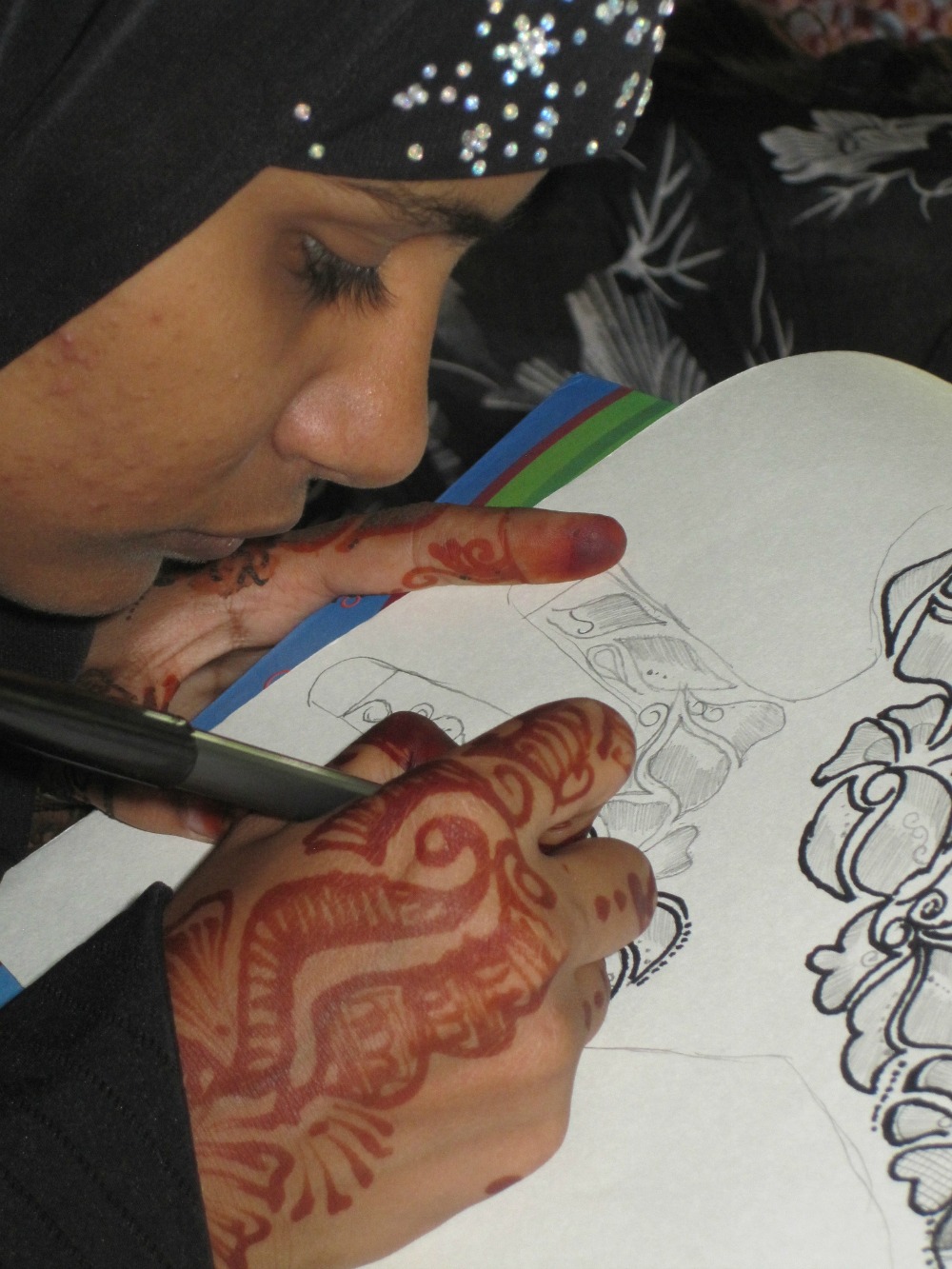 This young artist copied her own henna designs. This page celebrates the cultural and sexual freedoms of tribal women and people of transgender in western India, as portrayed through art and quilting. The project has resulted in one spectacular quilt, Henna Pride, which can be seen on the second tab together with profiles of the Indian artists who painted the henna squares. The story began in 2011, when the Vikalp Women’s Group, an AP partner that works for tribal women and transgender people in the state of Gujarat, expressed interest in advocacy quilting. Drawing and painting are part of tribal culture in the Narmada District of Gujarat, and it is common to see walls covered by brightly painted designs of horses and people in the local pithora style. Vikalp thought that a quilt would allow its marginalized stakeholders a chance to describe their culture. AP hoped to use the quilt to promote Vikalp’s work in the US. 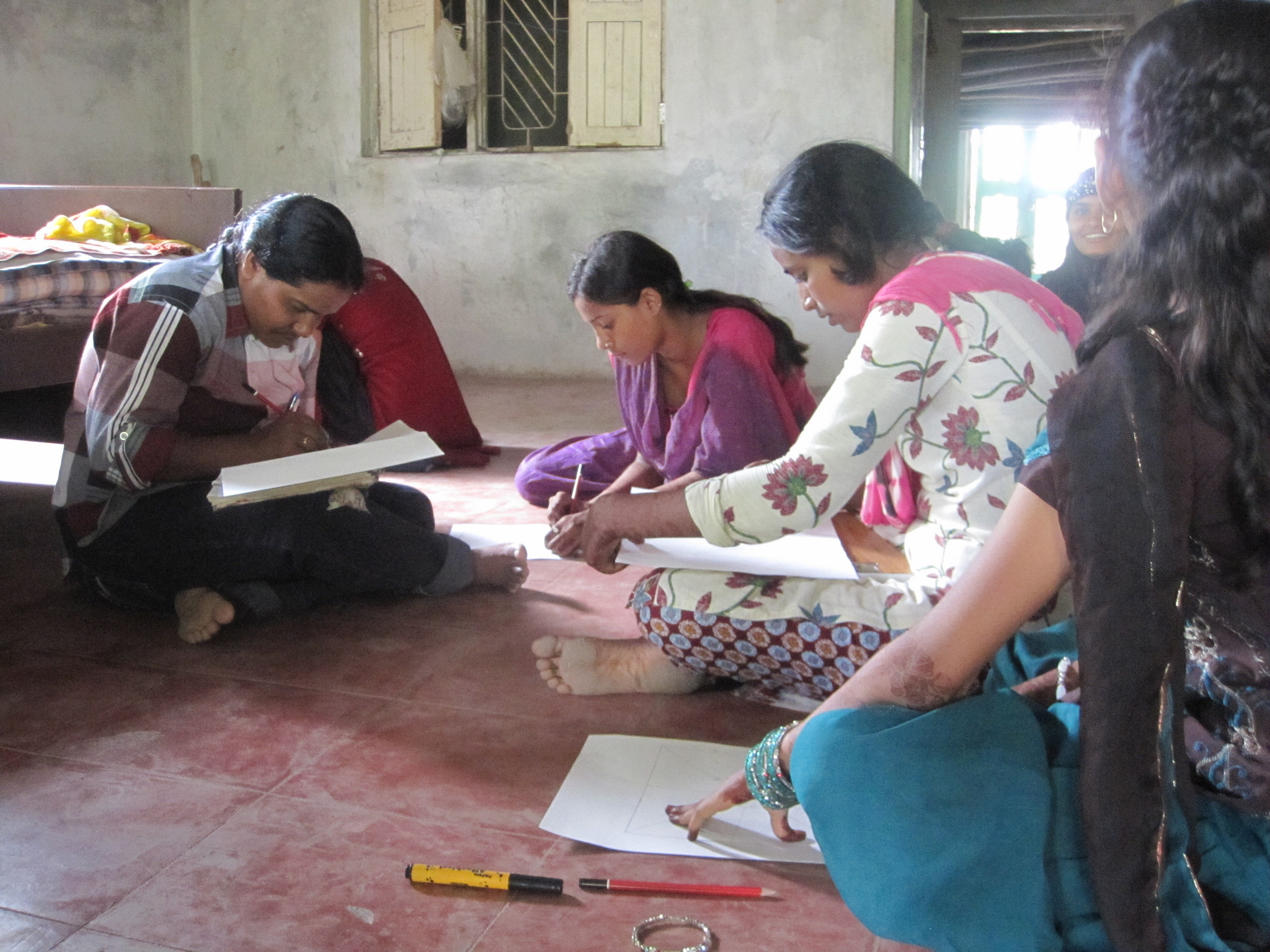 Tribal expression: Tribal women and girls describe their lives through paintings in 2012. In July 2012, Vikalp organized a painting session for about 25 tribal women in the community of Tilakwada, with support from Alicia Evangelides, the 2012 Peace Fellow. Many were judges on the Mahila Panch, one of two women’s courts that had been established by Vikalp to provide legal assistance to tribal and other minority women. Bilkis, one of the Mahila Panch judges and a respected member of Tilakwada’s Muslim community, took the lead. Vikalp also invited members of the Tilakwada Adolescent Girls’ Group for Muslim girls, a group created by Vikalp, to participate. Using paper and drawing utensils provided by Vikalp, the artists produced brightly colored paintings and drawings about village life. One young woman copied the intricate henna designs on her own arms. Another painted the lotus, India’s national flower. Other paintings depicted food, birds, and homes. Many paintings are posted on the fourth tab on this page. They represent an exuberant expression of a culture that rarely finds its voice. 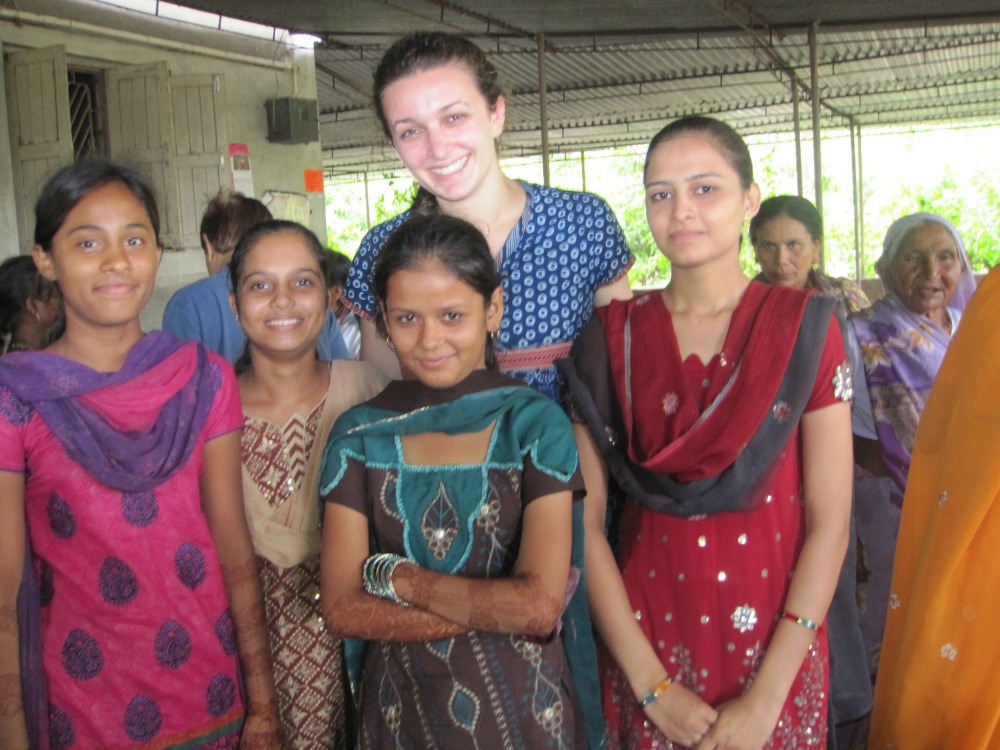 Peace Fellow Alicia Evangelides with young tribal painters As Alicia wrote in a blog , the painting sessions were also fun: “The event was a success, if I dare say so! Everyone seemed to enjoy themselves, and it was great to interact with these women outside of the more serious court setting.” Alicia also used this blog to provide some useful information about the culture of tribals, who accounted for 8.2% of the Indian population in 2012. Alicia brought the paintings back to the US, where they were handed over to Nancy Evans, an experienced quilter who had worked on several previous advocacy quilts with AP. Nancy spent many hours on the project but in the end the technical challenges of transferring the paintings onto cloth, and providing a unifying theme and design, proved too great. Instead, we decided to showcase as much of the art as possible on these pages. It can be found on the third tab, under the heading of the Vikalp Tribal Paintings. 2013
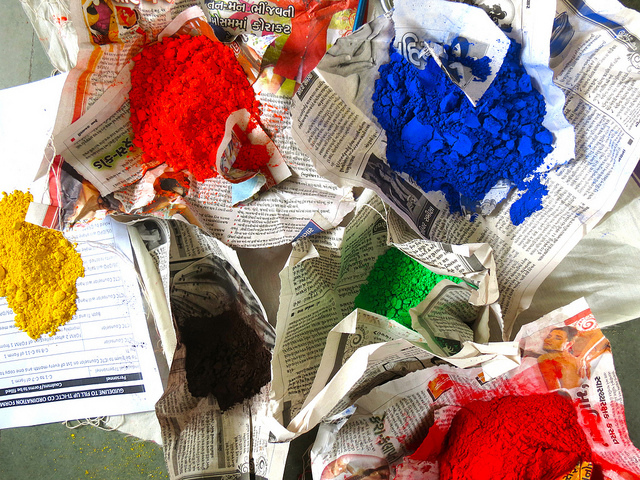 Purchasing paint in Baroda The 2011 paintings contained some wonderful artwork in the pithora style, for which Gujarat is known. They also included henna designs that are popular at festivals and weddings. After Vikalp expressed interest in a second attempt at a quilt, we suggested that a Pithora quilt might be representative of the local tribal culture and recruited two capable 2013 Peace Fellows, Andrea Bosneag and Pryia Desai, to help. After talking it through with Maya and Indira from Vikalp, Pryia and Andra set out on in search of artists (known asrangwallas) from the Rathwa tribal group who are known for their pithora painting. It turned into a 6-day “Huckleberry-esque adventure,” as Pryia called it in a blog. Several rangwallas lived in the village of Kanalwad, in Chottaudepur. Vikalp runs a successful project on HIV-AIDS in Chottaudepur and the coordinator of the project, Kusum, made an introduction to the rangwallas. Andra and Pryia found the village but not the artists, and returned empty-handed to Vikalp. They then purchased cloth and paint in the old town of Baroda and waited. A few days later, they received a call: four rangwallas had agreed to come to Kusum’s office and start painting! Pryia and Andrea set off again for Chottaudepur, with brushes, paints, a tripod, cameras and cotton squares. Pryia (who is Indian) asked the painters about their wonderful art, and noted the following in her blog: 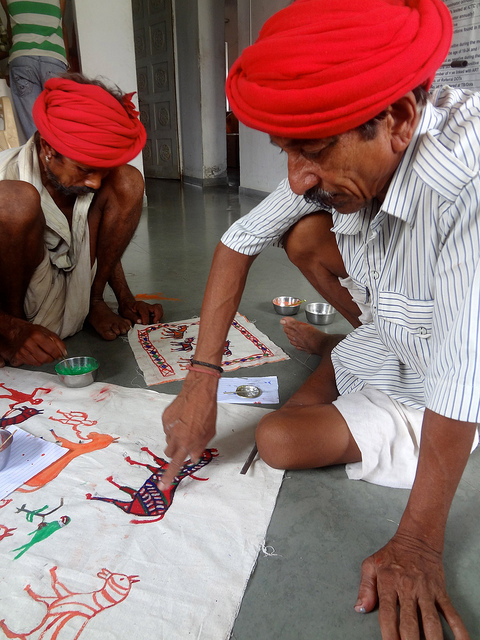 The painting team at Chottaudepur “Once a year, a family that has had a prosperous harvest will throw a feast for the entire village. Pithora painting will be done on their hut’s walls to celebrate the joyous occasion. Lamb will be cooked and eaten, and moonshine will be made from the mahura fruit. This moonshine is dribbled onto the pithora walls as a tribute to the gods. The pithora paintings depict agrarian themes focused on the sacred and profane. The primary figures in the paintings are horses – symbols of divinity and worship. The paintings depict themes of celebration – wedding palanquins, brides, moonshine, and elephants. The multiple headed demon is considered a god and demon alike, denoting the manifestation of good and evil within the same being.” Four hours and 17 minutes, the artists unveiled two splendid pithora paintings: Pryia and Andra finally had their “holy grail” as Pryia wrote. The painting team at Chottaudepur also produced several more delicate henna paintings, this time on cloth. Pryia and Andra returned to the US after their adventure with their precious paintings, which Pryia proudly displayed at the AP office. AP then took the paintings back to Nancy Evans. Once again, there were challenges. In the first place there were not enough paintings to make a full quilt. Second, the artists had not come from a marginalized community. Both issues were discussed among AP Board members, who decided to put the project on hold once again. Also quilter Nancy Evans still had no clear idea how to make a full quilt out of the paintings and another summer season of Fellows was approaching. This was the first time that AP and a partner had failed to produce a quilt, as planned, after no less than two attempts. Would there be a third attempt? 2014 Henna Pride
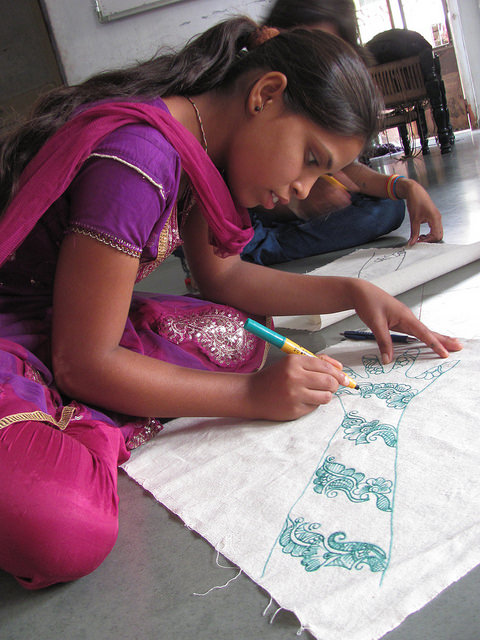 Artist at work on henna designs The answer would be yes – and this time it was to be third time lucky. During the summer of 2014, artists from the LGBTI community in Chhotaudepur would collaborate with quilters in the US to produce one of the most striking advocacy quilts ever made. The quilting was made easier by the fact that Vikalp’s own advocacy emerged from the shadows in 2013-2014. Vikalp has always offered a refuge to LGBTI, particularly transgender Females to Males (FTM) but this has been done discreetly. In 2011 AP had collaborated with Vikalp and the Georgetown Law School in 2011 to send two Peace Fellows to Vikalp to work for LGBTI rights. But that same year the Indian Supreme Court recriminalized homosexuality, and Vikalp decided to keep everything very low key The two summer Peace Fellows, Samantha Syverson and Meredith Williams made a website about Vikalp’s work for LGBTI, but under a pseudonym, Parma.
Iain Guest and Gisele Bolton, the 2014 Peace Fellow, met with Maya and Indira from Vikalp during a visit to New York in early 2014. In spite of the delays and mishaps, Maya and Indira expressed confidence that a quilt was still possible. They decided to enlist their Chhotaudepur staff members, who included several artists, and focus on henna designs. Gisele was designated to purchase materials and asked to coordinate. 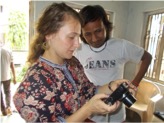 Peace Fellow Gisele and artist Payal review the photos This time it proved to be relatively straightforward. Gisele visited the Chhotaudepur office and found the atmosphere delightful. As she wrote in a blog: “This community is vibrant, diverse and full of energy. There is laughter and singing, with various people coming and going, the atmosphere is open and supportive. Both staff and individuals are free to be exactly who they are and discuss various issues without fear of judgment or discrimination. Everyone within this community cares for and supports one another. The project manager explained if an individual has an issue and the office isn’t open, or counselors aren’t available they reach out to one another for support.” 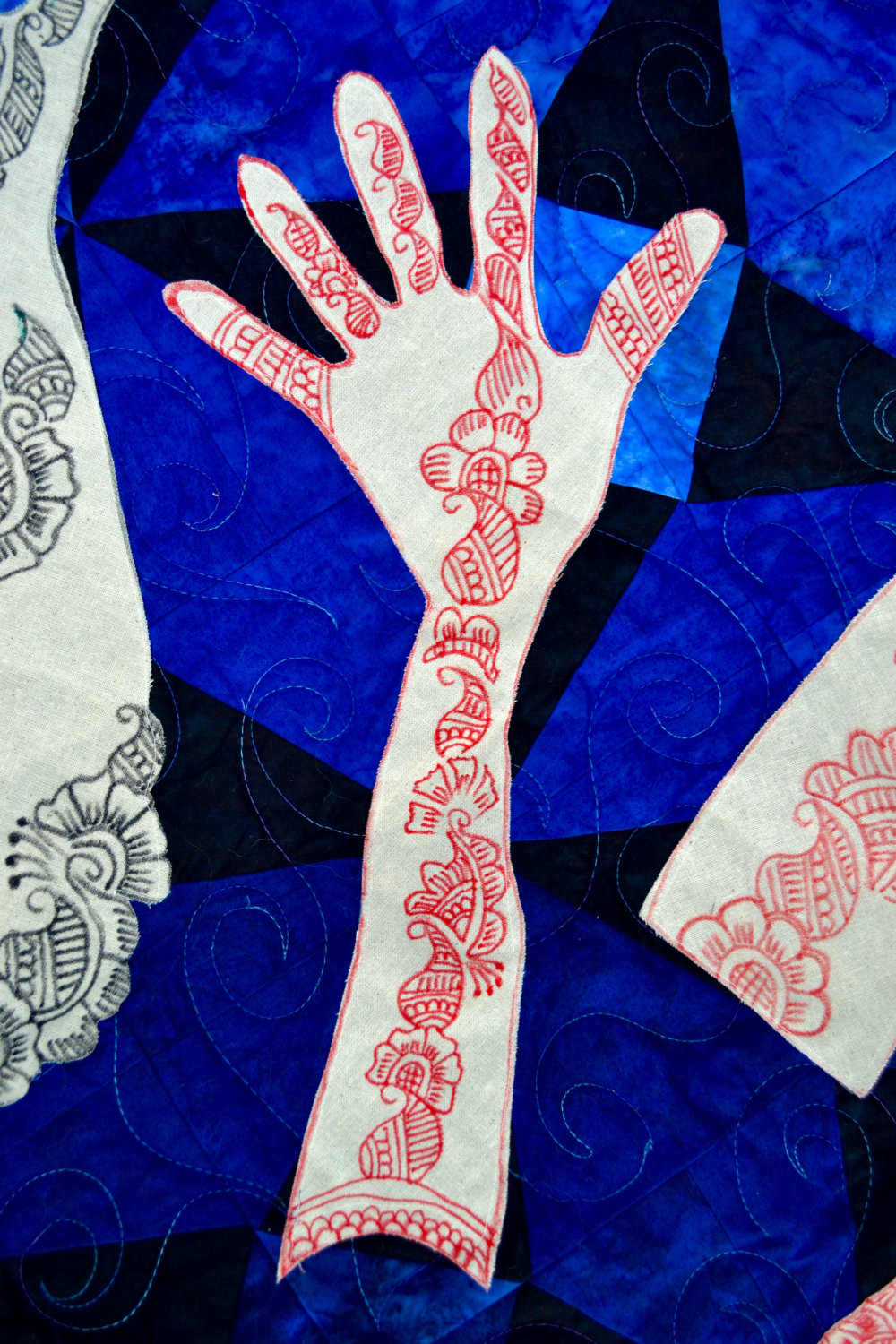 Henna Pride reaches for the light. Around eight artists, all Vikalp stakeholders, painted henna hands directly onto cloth. The project was led by Payal, a gay man who had been forced into an arranged marriage at a young age and found the welcoming atmosphere at Vikalp truly liberating. Like the others who participated, he is also a skilled artist. Vikalp’s profiles of the artists can be found on the next tab. They provide fascinating insight into the pressures that come from living a double life, as well as Vikalp’s own role in protecting members of the LGBTI community. Gisele took the finished paintings with her to Nepal when she left India and arranged for them to be hand-delivered to AP. They then went to Nancy Evans, the quilter. Nancy contacted a gay friend, John Anderson, who is a skilled quilter and together they came up with a striking design which shows the henna hands reaching up out of the gloom to seek enlightenment. They attached the hands to a rich dark blue backing. The quilt was delivered to AP in February 2015, in time to be exhibited for the first time at the prestigious New England Quilt Museum in Lowell Massachusetts. The next showing of Henna Pride will come in July, at the Long Beach Island Foundation in New Jersey. The quilt draws praise for the quality of its artwork and design, capping a long and fascinating 3-year attempt to give a voice to alternative artistic culture in western India. |
Henna Pride Quilt
Henna Pride Quilt
|
|
| Payal (Mukesh) – Project manager and henna artist
Payal, 30, is gay and married. He joined Vikalp when he was just Payal found Vikalp through activists who came to his village Jambugam. He would drive the 35 kilometers from Jambugam to Chhotaudepur in an over-packed jeep just to be with people like himself at Vikalp. Today he is a leader of his own group and supports many more youngsters in the rural, tribal areas around his village. He is also one of the few educated young tribals in his village. Married before he could complete his post-graduation, and much against his wishes, Payal has reconciled Payal is much sought at weddings and festivals, on account of his skills with henna designs. Deftly moving his fingers, he draws dancing filigree petals, plants and peacocks reaching up the sky. He also creates designs on the palms, wrists, arms and feet of young brides as they celebrate and prepare to leave their parental homes. It is Payal who adds the throbbing colors of joy and passion. These are also the times when she/he can dress and behave as a woman – to dance and rejoice in the festivity without raising eyebrows. |
| Gopi (Jiterendra) – LGBTI Support and Sexual Health Counselor
Gopi, also known by his birth name Jeetu, is unmarried and gay. He Shy and small in build, she/he is full of fun and laughter. When pressured to marry by his family, he chose silence and prevarication and in this way refused to be pinned down by his family: “I have a meeting today,” he would say. “So should I fix if for tomorrow, then?” asked his father. “I will tell you,” replied Gopi, patting his hair one last time and smiling as he made his way out. Once, after agreeing to a visit by the bride’s family, Gopi failed to even show up at home. Year after year, he kept making excuses.
Sometimes we see him in our homes on TV screens singing in a duet or in a group, dancing or singing. Sometimes we find his picture with his name on cassettes, as a singer of folk songs. He is a hit in his village and surrounding areas. This little guy who was once so shy is far from camera shy! She/he is a counselor, along with Payal, in the community group that Vikalp has helped to set up. Gopi has an equal number of male and female admirers. |
| Anika
Anika, a sex worker, had been with Vikalp for two years when she joined the Anika is not yet married, and this creates some difficulties. It is rare for a woman to remain unmarried before the age of 25, and single women of Anika’s age always attract suspicion. Uncomfortable with all this baggage, Anika Anika soon grew into her own person. “Overcoming my own diffidence was hardest” she confesses. “Next were the rules and norms by which good women had to live. I could not have abided by them and still earned my own living.” She began to dare to travel out alone. Bit by bit, she would even brave a late-evening-return home, using the local transport. She familiarized herself with the public world of men. Now she has her own strong network of friends and information – which is priceless and powerful. |
| Anish
Anish is openly gay. He has been part of the Vikalp
|
| Daksha
Daksha is a straight woman who joined Vikalp when Daksha is one of the advocates who has helped to run the women’s courts in Tilakwada, and this has helped her to survive her own family crisis. Having witnessed and even helped to arbitrate several cases of women who were exploited and battered by their husbands and their families, Daksha refused to succumb to her own husband’s alcoholic ravings and violence. After separating, she joined Vikalp’s group in Chottaudepur. As an outreach worker, Daksha goes far into the interior. She has a deep and instinctive knowledge of her own diverse community, and this brings a gender perspective that challenges us and makes us change. At the henna quilting sessions, Daksha takes care to serve us water, tea, snacks. She also makes us laugh at our roles, which she mimics, in order – as she says – “to refresh you all!” |
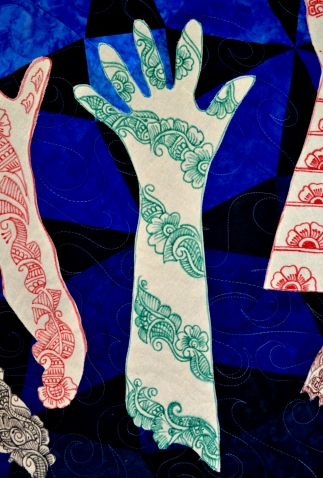 |
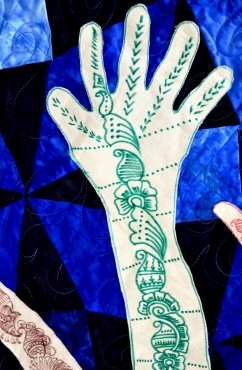 |
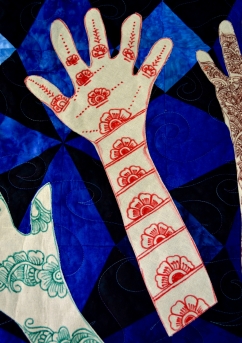 |
Vikalp Pithora Paintings
Vikalp Pithora Paintings
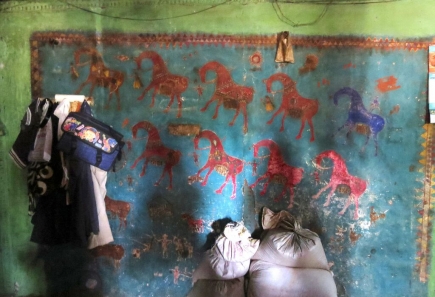 Paintings in the pithora style are part of tribal culture in the state of Gujarat. |
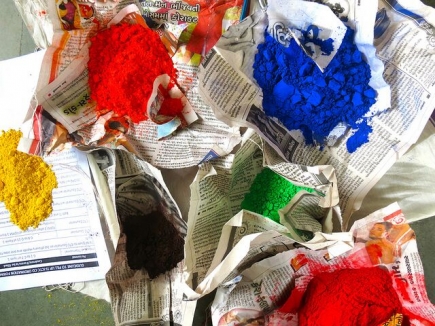 Peace Fellows Pryia Desai and Andra Bosneag scoured the old town of Baroda for artistic materials while waiting for the artists. |
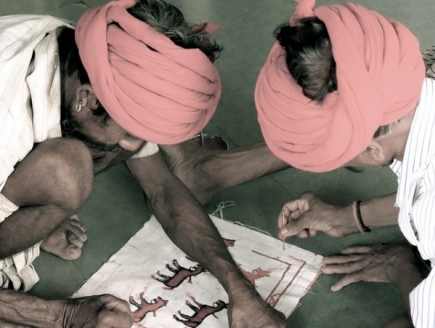 Several rangwallas (artists) from the Rathwa tribal group who specialized in the pithora style agreed to lend their skills to the project at the Vikalp office in Chottaudepur. |
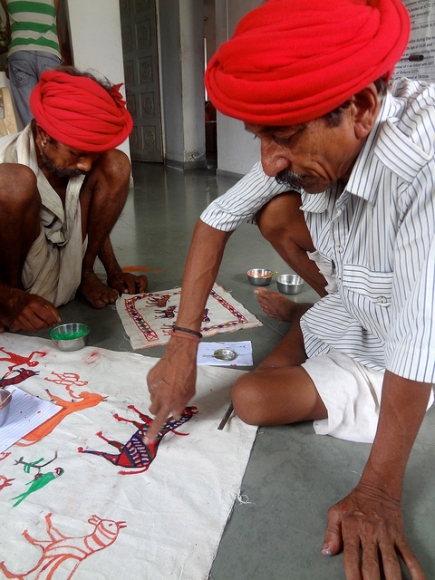 Horses are symbols of divinity and worship in Rathwa tribal culture. |
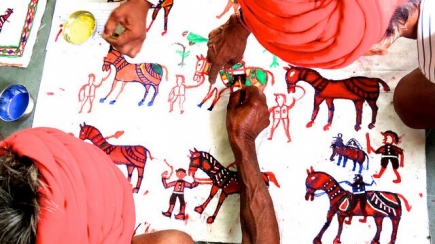 Putting the finishing touches to a splendid example of pithora art. |
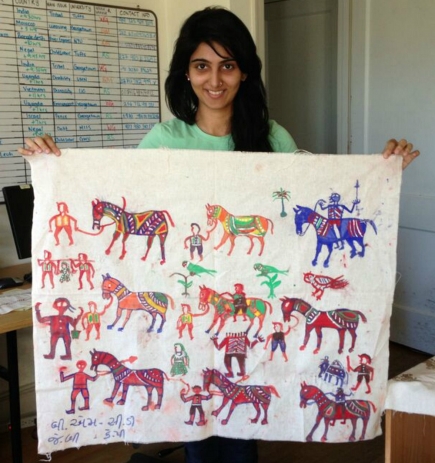 Pryia (right) and Andra brought the painting back to the US, where it will be assembled into an advocacy quilt to promote Vikalp and tribal culture. |
Vikalp Tribal Paintings
Vikalp Tribal Paintings
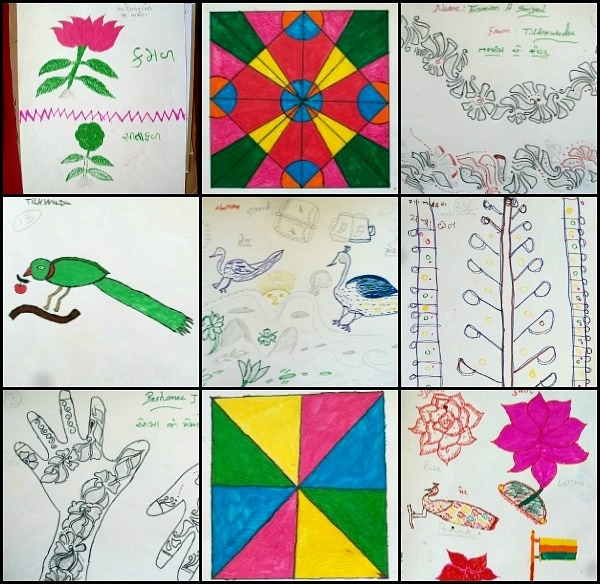 |
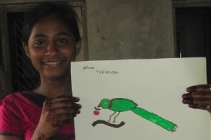 |
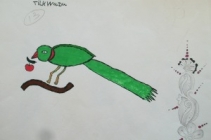 |
Unknown Artist A member of the Tilakwada Yuwati Manda with her quilt panel, a drawing of a parrot, representing the wildlife found in her village. |
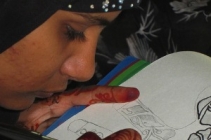 |
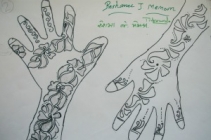 |
Unknown Artist A member of the Tilakwada Yuwati Manda shows off her completed panel. |
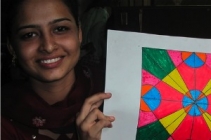 |
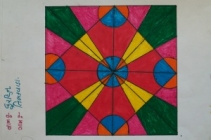 |
Unknown Artist A member of the Tilakwada Yuwati Manda shows off her completed panel. |
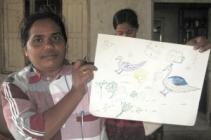 |
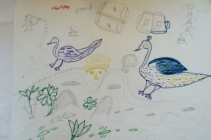 |
Champa Champa (Mahila Panch administrator) with her designs. |
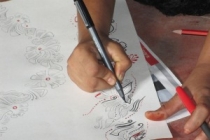 |
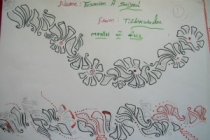 |
Unknown Artist Typical henna designs drawn on the hands of women in the tribal villages around Tilakwada. |
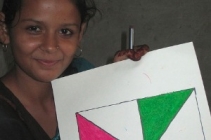 |
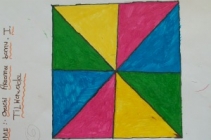 |
Unknown Artist |
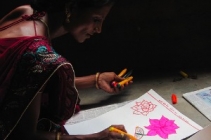 |
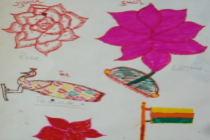 |
Unknown Artist |
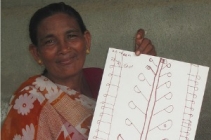 |
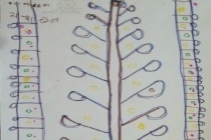 |
Unknown Artist |
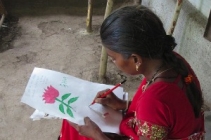 |
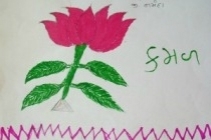 |
Jelly Jelly (Mahila Panch judge) and her quilt panel. |

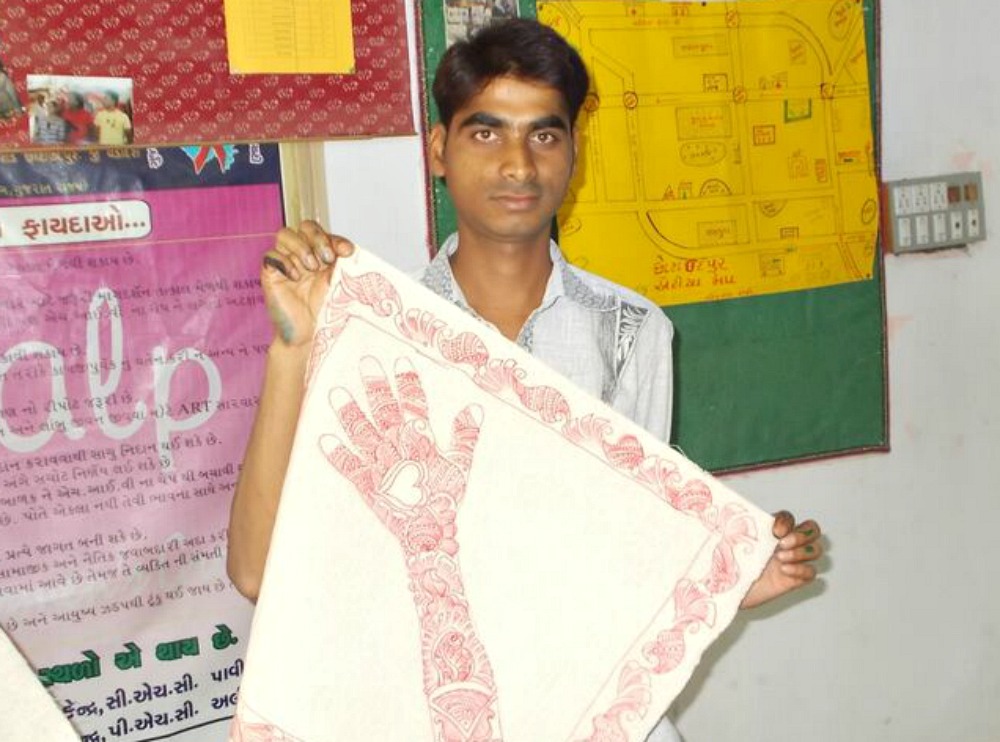 By 2014 the climate in India has changed. Homosexuality was still outlawed, but the Supreme Court had also created a third protected gender for transgender and transsexual people, known as hijra, which makes it illegal to openly discriminate against people of transgender. Vikalp was also more confident about its own advocacy on behalf of FTM and gays, and Vikalp’s project on HIV/AIDS education in Chhotaudepur was drawing government support, praise and volunteers. The Chhotaudepur office had become a refuge for sex workers, gays, FTM and others whose sexuality did not conform with the views of mainstream society.
By 2014 the climate in India has changed. Homosexuality was still outlawed, but the Supreme Court had also created a third protected gender for transgender and transsexual people, known as hijra, which makes it illegal to openly discriminate against people of transgender. Vikalp was also more confident about its own advocacy on behalf of FTM and gays, and Vikalp’s project on HIV/AIDS education in Chhotaudepur was drawing government support, praise and volunteers. The Chhotaudepur office had become a refuge for sex workers, gays, FTM and others whose sexuality did not conform with the views of mainstream society.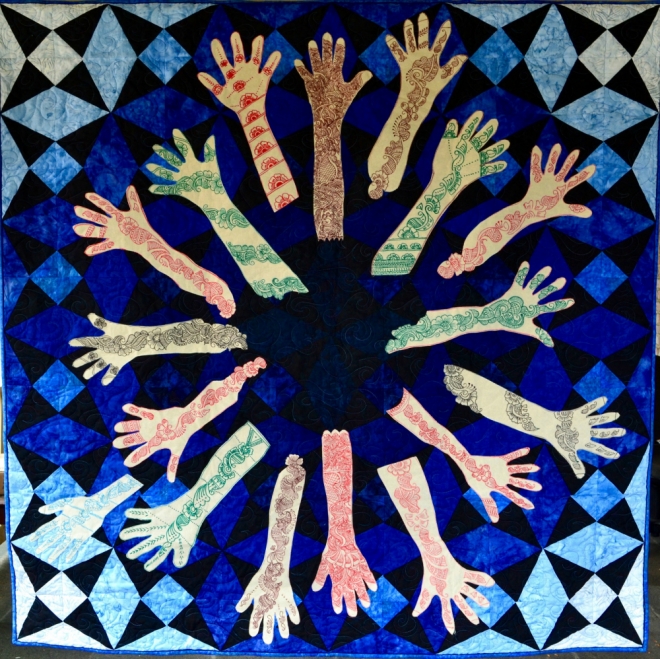
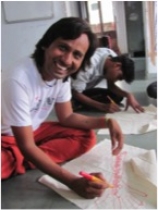 two years past adulthood. In the world outside and in his village he is known as Mukesh, but in Vikalp he is called by his preferred name, Payal.
two years past adulthood. In the world outside and in his village he is known as Mukesh, but in Vikalp he is called by his preferred name, Payal.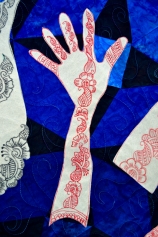 himself to a double life. He says: “Just as my parents have me in their old age I will have my children to count on…” Marriage has also given him cover for ‘time out,’ where he can express his otherwise illegal self, and a space to practice his craft.
himself to a double life. He says: “Just as my parents have me in their old age I will have my children to count on…” Marriage has also given him cover for ‘time out,’ where he can express his otherwise illegal self, and a space to practice his craft.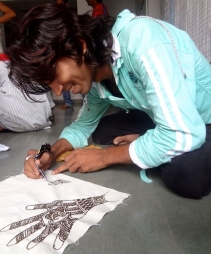 joined Vikalp eight years ago after being spotted in his native village, Kasipura, more than 50 kilometers from Chhotaudepur, by the growing queer community in Vikalp which took him in as “one of us.”
joined Vikalp eight years ago after being spotted in his native village, Kasipura, more than 50 kilometers from Chhotaudepur, by the growing queer community in Vikalp which took him in as “one of us.”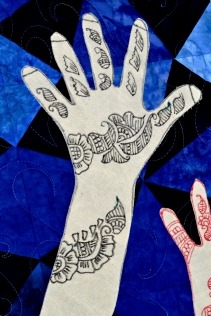
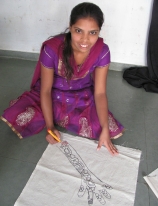 Henna Pride painting project. Like Payal, she comes from the village of Jambugam. Jambugam lies 10 kilometers from an expanding urban center, Bodeli, and this enables her to combine various jobs with her main skill, henna designs. On its own, designing henna does not provide an income.
Henna Pride painting project. Like Payal, she comes from the village of Jambugam. Jambugam lies 10 kilometers from an expanding urban center, Bodeli, and this enables her to combine various jobs with her main skill, henna designs. On its own, designing henna does not provide an income.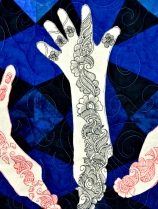 decided to change the rules of the game. She found Vikalp and gave voice to the inner identity that had been suppressed. She decided to turn her singleness to advantage. By taking her own decisions, she began to understand that human rights are entitlements that belong to all human beings – including women.
decided to change the rules of the game. She found Vikalp and gave voice to the inner identity that had been suppressed. She decided to turn her singleness to advantage. By taking her own decisions, she began to understand that human rights are entitlements that belong to all human beings – including women.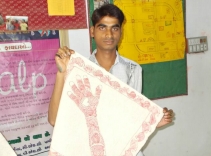 community for two years and comes to the office every week to enjoy the rich friendships he has built with both the staff and other community members. Anish is passionate about art and enjoys doing hair and makeup.
community for two years and comes to the office every week to enjoy the rich friendships he has built with both the staff and other community members. Anish is passionate about art and enjoys doing hair and makeup.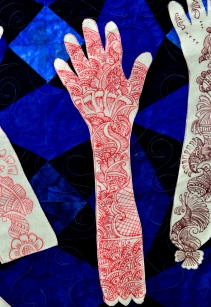
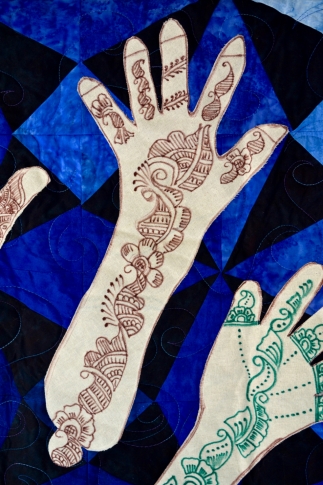 she was still unmarried, almost fifteen years ago. She then married and had a son, but returned to her mother’s house after being beaten by her husband.
she was still unmarried, almost fifteen years ago. She then married and had a son, but returned to her mother’s house after being beaten by her husband.